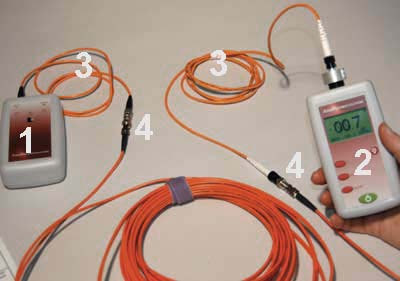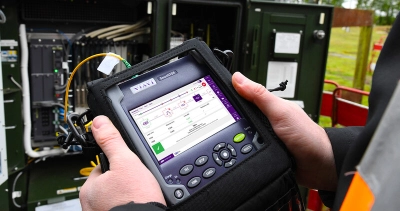Industries rely on fibre testing equipment to maintain product standards.
Wiki Article
Discovering the Conveniences of Optical Fiber Evaluating for Improved Interaction Systems
The significance of optical fibre testing in modern interaction systems can not be overemphasized, as it acts as a structure for guaranteeing network reliability and performance. Using innovative techniques such as Optical Time-Domain Reflectometry (OTDR) and insertion loss analysis, companies can not just recognize faults but likewise maximize their arrangements. This positive screening approach has extensive effects for signal top quality and operational performance, elevating the inquiry of how these practices contribute to long-lasting sustainability in an ever-evolving technical landscape. Understanding these characteristics is essential for stakeholders aiming to preserve an affordable edge.Relevance of Optical Fiber Testing
The value of optical fiber screening can not be overemphasized in today's data-driven setting. As organizations increasingly rely on high-speed information transmission for daily operations, the honesty and performance of optical fiber networks are vital. Evaluating makes certain that these networks can sustain the huge amounts of data produced and sent effortlessly, promoting efficient interaction and connectivity.Optical fiber testing serves several critical features, including validating setup top quality, recognizing potential mistakes, and determining total system performance. Normal testing can stop costly downtimes and service interruptions, permitting companies to preserve functional connection. Additionally, it helps in compliance with sector criteria and regulations, ensuring that fiber optic installments satisfy required requirements for safety and security and dependability.
Additionally, screening can boost the long life of fibre optic systems. By proactively identifying issues such as signal loss, depletion, or connector failings, companies can deal with problems prior to they intensify, thus extending the life of their framework. In summary, optical fiber screening is not simply a technical need but a calculated investment that boosts network dependability, maximizes efficiency, and eventually supports the growth and efficiency of modern interaction systems.
Secret Testing Techniques

OTDR is an essential technique used to determine faults, step splice losses, and assess the total integrity of a fiber optic web link. By sending out a pulse of light down the fibre and evaluating the reflected light, service technicians can determine locations of mistakes and review the network's efficiency over long distances.
Insertion loss testing measures the quantity of signal loss that occurs when light go through a link or splice. This approach is essential for confirming that connections fulfill specific loss limits, which is crucial for preserving ideal efficiency in interaction systems.
Optical return loss testing evaluates the quantity of light ofda reflected back in the direction of the source as a result of blemishes in the fiber or connections. High return loss worths suggest better performance and minimized signal degradation.
Together, these testing techniques give a thorough evaluation of fiber optic networks, ensuring their dependability and capability in varied communication applications.
Effect On System Performance
Effective optical fiber testing directly affects the total efficiency of interaction systems. By ensuring the integrity of fibre optic cables, screening determines potential faults such as attenuation, splice loss, and port misalignment. These concerns can dramatically break down signal quality, leading to disturbances and reduced data transmission rates.
Moreover, routine optical fibre screening adds to long-term system sustainability. It makes it possible for very early discovery of wear and tear, permitting prompt maintenance and upgrades prior to significant failings take place. This not just lengthens the lifespan of the infrastructure but additionally makes certain that interaction systems remain competitive in terms of efficiency.
Cost-Effectiveness and Performance
Cost-effectiveness is an essential factor to consider in the implementation and maintenance of optical fibre networks. Carrying out durable optical fiber screening procedures can dramatically minimize functional expenses by recognizing concerns prior to they escalate right into significant problems. ofda. By spotting mistakes, depletion, and other efficiency barriers early, companies can stay clear of pricey repair work and downtime, which can disrupt services and lead to profits lossIn addition, reliable screening methodologies enhance the setup process, allowing technicians to work extra successfully. This translates to decrease work expenses and faster job completion times. Advanced testing equipment, such as Optical Time Domain Name Reflectometers (OTDRs), makes it possible for an exact evaluation of fibre high quality, ensuring that just optimal products are used, consequently lessening waste.
Normal testing also adds to much better source allowance. By comprehending the network's performance, organizations can make educated decisions about upgrades and growths, guaranteeing that financial investments are made where they are most needed. In summary, optical fiber screening boosts cost-effectiveness and efficiency, supporting the lasting sustainability and competitiveness of interaction systems in an increasingly requiring market.
Making Sure Long-Term Reliability
Implementing strenuous optical fibre screening not just boosts expense savings and operational efficiency yet likewise plays a pivotal duty in making certain the lasting dependability of communication networks. Regular screening techniques, including attenuation and data transfer evaluations, assistance determine potential degradation in fiber performance before it brings about service disruptions.By utilizing advanced testing techniques, network drivers can pinpoint mistakes or weaknesses in the fiber facilities, enabling for prompt remediation. This proactive technique reduces downtime, guaranteeing that communication systems continue to be functional and effective. Regular screening adds to the advancement of a much more resilient network, as drivers can adjust and enhance their infrastructure based on real-time data understandings.
In addition, guaranteeing compliance with industry criteria via optical fibre testing reinforces the high quality and honesty of the whole interaction system. This adherence not only boosts confidence amongst stakeholders but also straightens with regulatory demands, which are progressively strict.
Final Thought
Finally, optical fiber testing works as an essential component in boosting communication systems. By using numerous testing approaches, such as OTDR and insertion loss evaluations, networks can accomplish optimum efficiency and dependability. The proactive recognition of faults not only boosts signal top quality however also decreases downtime, inevitably contributing to cost-effectiveness and operational efficiency. Additionally, adherence to sector requirements fosters stakeholder self-confidence, guaranteeing the long-lasting sustainability of communication frameworks in a significantly data-driven landscape.Report this wiki page